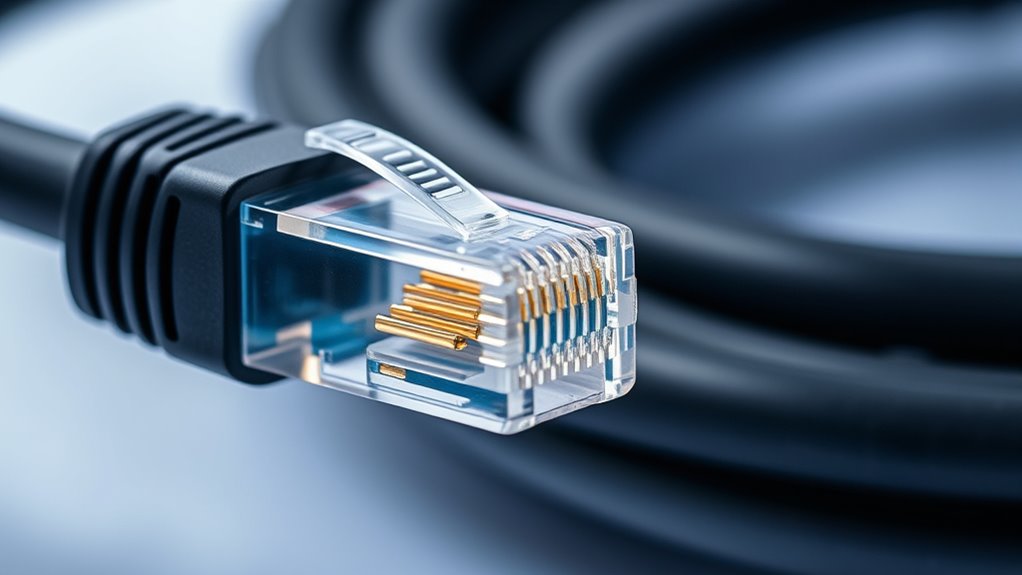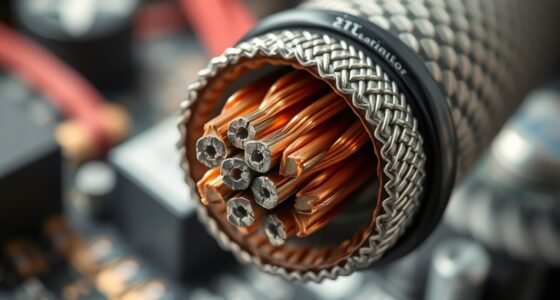Did you know that the cables connecting your devices are the backbone of digital communication, yet many people overlook their importance? Whether you’re setting up a home network or managing a large enterprise, choosing the right type of cable can considerably impact performance and reliability. Understanding what a network cable is and how it works might just change how you approach your next tech project—so let’s explore the basics together.
Key Takeaways
- Network cables are physical links that connect devices, enabling data transfer within digital communication systems.
- They include types like fiber optic cables and twisted pair cables, each suited for different speeds and distances.
- Fiber optic cables transmit data via light pulses, offering high speeds and resistance to electromagnetic interference.
- Twisted pair cables, such as UTP and STP, use insulated copper wires twisted together to reduce interference and maintain signal quality.
- Choosing the right network cable depends on factors like speed, distance, environment, and budget to ensure optimal network performance.

Have you ever wondered how your computer connects to the internet or local networks? The answer lies in network cables, which serve as the physical links that transfer data between devices. These cables come in various types, each designed for specific speeds, distances, and environments. Understanding what a network cable is and how it works is essential to grasp how digital communication happens behind the scenes. At their core, network cables are insulated wires that carry electrical or optical signals, enabling data to travel from one device to another. The most common types you’ll encounter are fiber optic cables and twisted pair cables. Fiber optic cables use pulses of light to transmit data, offering extremely high speeds and long-distance capabilities. They consist of thin strands of glass or plastic that carry data as light signals, making them ideal for backbone connections in large networks or internet service providers. On the other hand, twisted pair cables are more prevalent in everyday settings, like homes and offices. These cables contain pairs of insulated copper wires twisted around each other to reduce electromagnetic interference, which helps maintain signal quality. Twisted pair cables are versatile, affordable, and easy to install, making them the go-to choice for Ethernet networks. They come in two main varieties: unshielded twisted pair (UTP) and shielded twisted pair (STP). UTP cables are common in most office and home setups, while STP offers extra protection against interference, suitable for environments with a lot of electronic noise. When you’re setting up a network, choosing the right cable depends on your needs. Fiber optic cables deliver incredible bandwidth and are less susceptible to interference, but they’re more delicate and costly. Twisted pair cables, though limited in speed compared to fiber, are generally easier to install and maintain. Both types connect your devices to routers, switches, and modems, forming the physical infrastructure that supports your digital life. The connectors at the ends of these cables—like RJ45 for twisted pair—are just as important as the cables themselves, ensuring a secure, reliable link. Whether you’re setting up a home network or managing large-scale enterprise systems, understanding these basics helps you make informed decisions. In essence, network cables act as the pathways for your data, with fiber optic offering speed and long-range capabilities, and twisted pair providing practicality and affordability. Knowing the differences allows you to optimize your network’s performance and reliability. So next time you connect your computer or troubleshoot your internet, remember that these cables are the silent workhorses making it all possible, bridging the digital world with the physical infrastructure that keeps everything running smoothly. Additionally, the choice of cable types can significantly impact your network’s overall speed and performance.
Frequently Asked Questions
Are Network Cables Compatible With All Devices?
Of course, network cables are compatible with all devices—unless they’re wireless alternatives, which don’t need cables at all. While some cables offer extensive shielding for interference resistance, not all devices require such protection. You might find that certain older gadgets need specific connectors, but generally, as long as your device matches the cable type, compatibility’s a breeze. Otherwise, you’re just chasing a perfect connection in a world of wireless convenience.
How Long Can a Network Cable Run Before Signal Loss?
You can typically run a network cable up to 100 meters (about 328 feet) before signal degradation becomes an issue. Beyond this length, cable length limitations lead to increased signal loss and slower data transmission. To maintain peak performance, avoid exceeding this distance, or consider using network switches or repeaters to extend the range without compromising signal quality. Staying within cable length limits ensures reliable, fast connections.
What Are the Environmental Considerations for Cable Installation?
You need to take into account environmental durability and cable insulation during installation. Choose cables with insulation suited for your environment, whether it’s moisture, heat, or chemicals. Avoid exposing cables to direct sunlight, extreme temperatures, or water, which can degrade performance. Properly securing and protecting cables from physical damage also helps maintain signal integrity. Planning for environmental factors ensures your network remains reliable and efficient over time.
Can Network Cables Be Used Outdoors?
You can definitely use network cables outdoors, but it’s not as simple as plugging them in. You’ll want cables with strong outdoor durability and weather resistance, so they can withstand the elements. Think of it as putting on a raincoat—you need protection from rain, sun, and extreme temperatures. Using the right outdoor-rated cables guarantees your network remains reliable and safe, even when Mother Nature throws her worst at you.
How Do I Troubleshoot a Faulty Network Cable?
You should start by testing the cable with a cable tester to identify any faults. If the test shows issues, check the connectors for damage or corrosion, and consider repairing or replacing them if needed. For minor problems, you can attempt connector repair by re-crimping or re-soldering. Always guarantee the cable is properly connected and seated, and replace any visibly damaged sections to restore peak network performance.
Conclusion
Now that you know what a network cable is, you’re equipped to make smarter choices for your setup. Whether you opt for fiber optic’s lightning-fast speed or the versatility of twisted pair cables, choosing the right cable can transform your network from sluggish to supercharged. Remember, selecting the perfect cable isn’t just a minor detail—it’s the backbone of a reliable, high-performance connection that keeps your digital world running smoothly like a well-oiled machine.









